Jeremie Averous's Blog, page 121
May 3, 2014
How to Focus on Execution and Still be Open to New Ideas
As an entrepreneur and a creative writer, I steadily encounter the issue of having too many ideas popping up even in the middle of the (painful) execution of a previous idea. The same can be said of business opportunities, which are but a certain version of an idea.
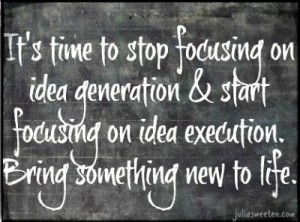 Ideas are cheap until they are executed; and execution is tough – you can’t execute so many ideas simultaneously with the right focus – a focus that is required to be ultimately successful. And time is scarce so you can’t properly execute fully too many ideas in a given timeframe.
Ideas are cheap until they are executed; and execution is tough – you can’t execute so many ideas simultaneously with the right focus – a focus that is required to be ultimately successful. And time is scarce so you can’t properly execute fully too many ideas in a given timeframe.
One of the issues is of course that during execution, new ideas will necessarily pop up from the work that you can’t just throw away for later. And some more from your life. What can you do? Bloggers and authors suggest several opposed strategies which can be summarized as follows:
Note new ideas for later and ignore them for the time being (so as not to lose focus)
Don’t bother about the sunken costs of what you’ve been doing – if a new idea has much higher merit just go for it, now (in start-up talk, “pivot”!)
I tend to believe that there is value being persistent in the execution of a idea, even if it does not turn out to be as successful as anticipated. The learning from executing an idea until the end is invaluable. At the same time, if a really great idea crosses your life it would be dumb not to go for it – but that should be quite a rare thing.
I thus suggest to go for a middle road: don’t stop executing what you’re doing but still do a basic ‘due diligence’ on your new ideas to evaluate their potential before deciding to go for it or not. In marketing terms, have an idea funnel. But still, do finalize execution on some ideas to get the learning, and limit the number of ideas you pursue at any one time to a handful!
Picture from Julia Sweeten’s blog post Stop Generating New Ideas with is a great glimpse into the struggles of the creator (although the issue might not be to stop generating ideas but how to recognize if a new idea might have more merit and value than the one you’re executing).

May 1, 2014
Why Organization’s Stability Should Be Used To Enhance External Disruption
Following on our latest post on the increase of the world’s unpredictability, Robert Branche makes also an excellent point that as nature designed living organisms that would dramatically increase the unpredictability of the world, it had to design organisms that were more stable inside. And actually, from plants to animals, to mammals, internal stability has increased dramatically with evolution.

A storm on stability
This is a very interesting contradiction: to enhance the world’s changes, internal stability is required. And this observation actually applies to many situations.
Robert Branche extends this observation to organizations: for him, companies or organizations are a way to build an internal stability to become able to transform the world. “Internal order and rules should not reduce uncertainty, but make its development and acceptance easier” states Robert Branche in the case of large corporations.
Organizations that would implement internal rules for the sake of increasing internal and external certainty are ultimately doomed. Organizations need to develop and nurture internal stability as a way to enhance their disruptive impact on the world.
What a challenge to all established organizations!
How does your organization fare? Is it really defending its stability to make a bigger, more disruptive impact on the world?
Reference is made to Robert Branche‘s latest book “les Radeaux de Feu” (in French). Visit Robert Branche’s blog (in French) for more about the author and his latest book.

April 29, 2014
Why our World’s Unpredictability Ever Increases
Robert Branche in his excellent new book, “les Radeaux de Feu” (in French) makes an extremely interesting point about the fact that entropy – the natural evolution of the universe – is not about increasing disorder, but is all about increasing unpredictability.
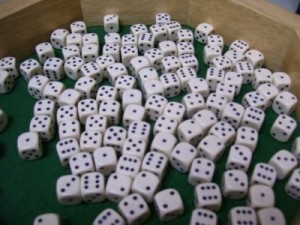 His thesis is then that all of nature’s invention – life, first cells, then plants, then animals and ultimately humans – is all about increasing dramatically unpredictability of the world. And it is true that at each step, the number of possible future states increases dramatically. Today humans have transformed the world at a much higher and unpredictable pace than plants have ever done, or than the mineral world has ever achieved.
His thesis is then that all of nature’s invention – life, first cells, then plants, then animals and ultimately humans – is all about increasing dramatically unpredictability of the world. And it is true that at each step, the number of possible future states increases dramatically. Today humans have transformed the world at a much higher and unpredictable pace than plants have ever done, or than the mineral world has ever achieved.
What lesson does it bear for us? It is clear that unpredictability of our life, of our world will ever increase at an accelerated pace – that is a physical law. And the Fourth Revolution, this inter-connection of humans, will accelerate that transformation even more. We should not be looking for any stability soon. So instead of complaining, let’s rather enjoy the transformation!
Visit Robert Branche’s blog (in French) for more about the author and his latest book.

April 26, 2014
Why You Should Focus on Your Life’s ‘Body of Work’
Pamela Slim, the author of Escape From Cubicle Nation, just released an other book, Body of Work: Finding the Thread That Ties Your Story Together.
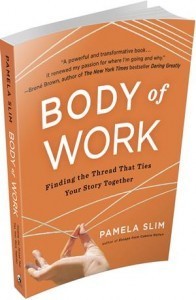 She takes an interesting view on the fact that we actually create a Body of Work in our lifetimes, that ties together all our experiences – even if they do not seem connected. In hindsight, the sum of our experiences will make sense. Why not reinforce this meaning voluntarily from now on?
She takes an interesting view on the fact that we actually create a Body of Work in our lifetimes, that ties together all our experiences – even if they do not seem connected. In hindsight, the sum of our experiences will make sense. Why not reinforce this meaning voluntarily from now on?
Pamela writes: “Viewing your life as a body of work is not a short-term game. You want to focus on meaning, skill development, professional network development, craft and mastery. There is no one right answer for everyone.”
The book is full of examples of people that change radically their careers and lives and still find a way to bring everything back into their body of work – and expand it further, meaningfully, by opening themselves to new encounters and experiences.
You are in charge of creating your Body of Work. Take this responsibility and create this incredible story you will be able to tie up together in hindsight. Like we already mentioned in this blog, Life is Not about Finding Yourself, Life is about Creating Yourself!

April 24, 2014
How to Overcome the Greatest Problem in Communication
“The greatest problem in communication is the illusion that it has been accomplished” – George Bernard Shaw.
 I can observe every day in my consulting practice how this old quote is so true, in particular in large organizations. Top management often confuses the act of communicating with actual communication.
I can observe every day in my consulting practice how this old quote is so true, in particular in large organizations. Top management often confuses the act of communicating with actual communication.
It takes a lot of effort and caring to ensure proper communication. That means actual, down-to-earth leadership, and consistency through time.
I like to think that this issue can be solve through enough caring: what is communication if you don’t care about how well the message has been received and understood? It is about acknowledging the emotional component and be emphatic to the actual reception.
Be open and listen actively to assess the result of your communication. Don’t just deliver a message: observe its effect and ensure ‘after-sales’ service in the form of emphatic listening!

April 22, 2014
Where to Find Meaning in Life
According to Viktor Frankl, the author of ‘Man’s Search for Meaning‘ (ref. our post ‘How We Always Have a Choice, Even in the Worst Situation‘), there are three possible positive sources of Meaning: in Work (doing something significant), in Love (caring for another person), and in Courage during difficult times.
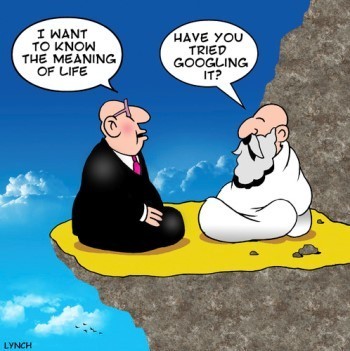 As we evolve in life, the source where we seek out meaning might evolve and change. The overall meaning of our life will only make sense at the very end. “We cannot understand the whole film without having first understood each of its components, each of the individual pictures. Isn’t it the same with life? Doesn’t the final meaning of life, too, reveal itself, if at all, only at its end, on the verge of death? And doesn’t this final meaning, too, depend on whether or not the potential meaning of each single situation has been actualized to the best of the respective individual’s knowledge and belief?”
As we evolve in life, the source where we seek out meaning might evolve and change. The overall meaning of our life will only make sense at the very end. “We cannot understand the whole film without having first understood each of its components, each of the individual pictures. Isn’t it the same with life? Doesn’t the final meaning of life, too, reveal itself, if at all, only at its end, on the verge of death? And doesn’t this final meaning, too, depend on whether or not the potential meaning of each single situation has been actualized to the best of the respective individual’s knowledge and belief?”
Notwithstanding that it will all make sense at the end and not before, are you doing your best finding meaning in a meaningful work, love for another person or courage facing a difficult situation?

April 19, 2014
What is Perfectionism and How to Overcome It
Some would say I am a recovering perfectionist (while I do not really feel that way). I can certainly be very detailed-oriented but can now also let go and ship to the world even if I know it is not perfect. What maybe I did not understand well was the mechanism of perfectionism.
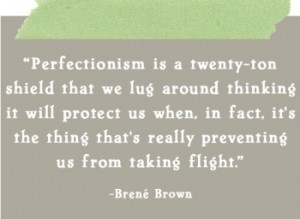 I found a great summary of this issue in an excellent book I read recently. “Perfectionism is a self-destructive and addictive belief system that fuels this primary thought: If I look perfect, live perfectly, and do everything perfectly, I can avoid or minimize the painful feelings of shame, judgment, and blame. Perfectionism is self-destructive simply because there is no such thing as perfect” – so writes Brene Brown in the Gifts of Imperfection: Let Go of Who You Think You’re Supposed to Be and Embrace Who You Are (she is an academic researcher on blame and became a best-selling author on the topic of becoming what we really are).
I found a great summary of this issue in an excellent book I read recently. “Perfectionism is a self-destructive and addictive belief system that fuels this primary thought: If I look perfect, live perfectly, and do everything perfectly, I can avoid or minimize the painful feelings of shame, judgment, and blame. Perfectionism is self-destructive simply because there is no such thing as perfect” – so writes Brene Brown in the Gifts of Imperfection: Let Go of Who You Think You’re Supposed to Be and Embrace Who You Are (she is an academic researcher on blame and became a best-selling author on the topic of becoming what we really are).
What she points out is that perfectionism is in fact an addiction that aims to protect us from the outside world – and thus could be compared to alcohol or drugs somehow. Overcoming perfectionism also requires the same tools and habit-forming activities than other addictions, and possibly external help as well.
Being careful in what you are doing is fine. But if you overextend it because you fear what people might think of you, and then you don’t come out to the world, you might suffer from an addiction to perfectionism. Heal yourself!

April 17, 2014
What is True Mastery?
“True mastery comes from discovering the ‘simplicity’ on the other side of complexity” – Dan Ward.
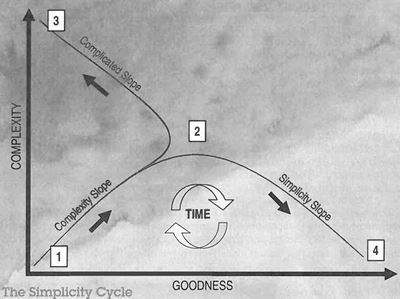 Dan Ward is an interesting phenomenon – senior purchaser with the US Air Force he is also a prolific writer on the topic of complexity. The Simplicity Cycle is a great piece of thought – here is the link to the Simplicity Cycle Paper or alternatively, the Simplicity Cycle slideshow.
Dan Ward is an interesting phenomenon – senior purchaser with the US Air Force he is also a prolific writer on the topic of complexity. The Simplicity Cycle is a great piece of thought – here is the link to the Simplicity Cycle Paper or alternatively, the Simplicity Cycle slideshow.
He has an interesting take on the fact that development of a great item needs to initially start with increasing complexity – but that after some stage it needs to migrate to the search for simplicity – and that otherwise goodness decreases with increasing complexity.
“Perfection [in design] is achieved not when there is something more to add, but rather when there is nothing more to take away” – Eric Raymond. A great definition of the Graal of design and of the evolution of any system. And a great definition Mastery: one who knows how to simplify the complex can increase significantly its impact on the world!
Hat tip to Tony Farrow for the link to Dan Ward’s work.

April 15, 2014
Why Quantity is not Quality for Reports and Presentations
I often experience that a thick-looking report, or presentation, benefits from a positive first impression, in particular in traditional corporate settings – notwithstanding the quality of its contents. This is wrong!
 Pamela Slim in her latest book ‘Body of Work‘ mentions that “There is a conspiracy cooked up by marketing wonks, consultants, and executives to pay for words by the pound, and to question the intelligence of a corporate “professional” who does not create complex and obtuse presentations. They are wrong. Your instinct to keep things clean and simple is right.” She quotes an experience where she sat for a few hours through a powerpoint presentation in a corporate setting without being able to understand what it actually was about.
Pamela Slim in her latest book ‘Body of Work‘ mentions that “There is a conspiracy cooked up by marketing wonks, consultants, and executives to pay for words by the pound, and to question the intelligence of a corporate “professional” who does not create complex and obtuse presentations. They are wrong. Your instinct to keep things clean and simple is right.” She quotes an experience where she sat for a few hours through a powerpoint presentation in a corporate setting without being able to understand what it actually was about.
Sometimes, providing a long presentation is also a way to hide from the fear of having a real candid conversation about the issue at hand, making sure that the allocated time is spent looking at a content that has been carefully polished, and avoiding questions and debate.
While substantial evidence backups might need to be gathered separately (as an appendix), I believe that the presentation or report message needs to be clear and crisp and should ideally be delivered in less than 25% of time allocated for that particular discussion – or at the minimum leave time to elicit proper discussion while the material is presented.
The value lies in the confrontation of ideas and in the discussion. The quality of the presentation or the report is to act as a sound trigger for that discussion. Never judge the quality of their content separately from the discussion – and possibly the decision – that it will trigger.

April 12, 2014
Why You Should Become Better at Change… by Practicing Change
“Getting good at change (big, small, tiny – every day) means getting good at life” writes James Altucher in this excellent post.
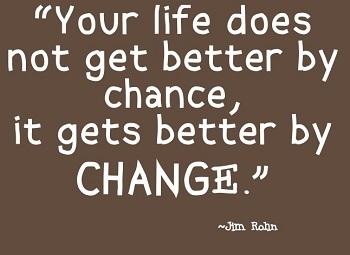 We certainly all need to become better at taking change as an opportunity rather than a threat. Change is actually always quite good in terms of excitement and learning. ”When you change you go from a flattening learning curve (your old situation) to a steep learning curve (the new situation). Steep learning curves feel good. Like the feeling of new love.”
We certainly all need to become better at taking change as an opportunity rather than a threat. Change is actually always quite good in terms of excitement and learning. ”When you change you go from a flattening learning curve (your old situation) to a steep learning curve (the new situation). Steep learning curves feel good. Like the feeling of new love.”
Of course, changes are not always ignited by us; they can be the result of external forces we don’t control. Sometimes one reason we suffer too much is because we’ve become rusty at change, because we don’t practice enough; we have become too sedentary in our habits. One key secret is probably to exercise at change by changing often. By becoming a nomad of sorts when it comes to our habits. We can exercise this very well by travelling; by relocating elsewhere; and by trying to change our habits and activities often.
A final word from James Altucher: “[Change] without expectation. Wish for nothing. Care for everything. Happiness will be in between“.
Go for it!




